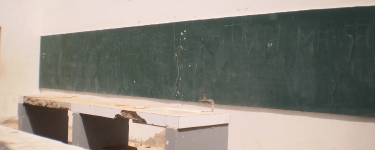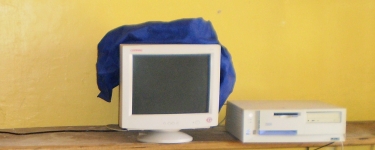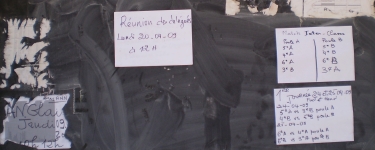Why School Management Software?
 Distributing school management software is the cheapest way to positively impact millions of people and improve the quality of education in Africa. Properly implemented, school management software has the ability to promote technology in schools, reduce corruption, lower school operating costs, and increase administrative efficiency and the utilization of existing resources. It gives schools a reason to adopt new technology and students a clear example of how IT can improve their lives. It can do all of this at an implementation cost that is recouped in the course of a single school year. The average direct savings for a school in Senegal has been 1000 work hours and $200 dollars annually. This covers the cost of purchasing a computer and printer. The average savings in labor can allow a school to replace two school administrators with teachers.
Distributing school management software is the cheapest way to positively impact millions of people and improve the quality of education in Africa. Properly implemented, school management software has the ability to promote technology in schools, reduce corruption, lower school operating costs, and increase administrative efficiency and the utilization of existing resources. It gives schools a reason to adopt new technology and students a clear example of how IT can improve their lives. It can do all of this at an implementation cost that is recouped in the course of a single school year. The average direct savings for a school in Senegal has been 1000 work hours and $200 dollars annually. This covers the cost of purchasing a computer and printer. The average savings in labor can allow a school to replace two school administrators with teachers.
Software reduces corruption
Corruption is a fact of life in many schools in Africa. Money changes hands between parents and administrators or principals so that an unqualified student can access a higher grade level or change a test score to receive a scholarship. Such forms of bribery give those with means an unfair advantage over better-qualified students.
Best Grade reduces corruption by improving transparency and altering the way grades are recorded. Grades are either entered or verified by a third party, whose work can easily be checked by teachers. Student averages are calculated automatically and cannot be “mistakenly” inflated, so administrators cannot arbitrarily change grades. Furthermore, changes will have to be verified by a system administrator, ensuring another level of security.
Software saves schools money
The average school size is 1000 students, in 20 classes. A customized grade bulletin notebook must be ordered for each class, at a cost of $15, or $300 for the school. In lieu of this expense, bulletins are printed using Best Grade. Average printing costs are high, roughly 10 cents per page, and 2 report cards are printed per page. Total printing expenses: $50. Annual depreciation of equipment $50. The total savings of $200 is the difference between the original cost and the new expenses.
Software saves schools time
A teacher spends on average 3 minutes calculating and recording a homework and overall grade for a student. For a school of 1000 students with 12 classes each, this takes 36,000 minutes, or 600 hours. Additionally, an administrator spends 30 minutes per student calculating final grades and rank, or a total of 500 hours per school. They spend another 500 hours compiling student lists and recording by hand permanent records, id cards, and certificates of enrollment.
With Best Grade all tasks can be completed in less than a third the time. Furthermore, teachers are no longer required to calculate student and overall averages.
Why Best Grade Works for Schools?
 While a host of competitors failed to gain a foothold in the market, Best Grade succeeded because of a ground level up approach to design. It was developed with extensive input from the local level, including direct interaction with various school in urban and semi-urban areas over a period of months. It is the only school management software specifically tailored to conditions on the ground across Sub-Saharan Africa. It has gained a foothold because it fundamentally does not alter the balance of power or workload in schools between teachers, administrators, and principals.
While a host of competitors failed to gain a foothold in the market, Best Grade succeeded because of a ground level up approach to design. It was developed with extensive input from the local level, including direct interaction with various school in urban and semi-urban areas over a period of months. It is the only school management software specifically tailored to conditions on the ground across Sub-Saharan Africa. It has gained a foothold because it fundamentally does not alter the balance of power or workload in schools between teachers, administrators, and principals.
Functionality, Flexibility, Ease of use
Three design aspects are crucial to the product’s success: its comprehensive functionality, its flexibility in terms of customization and adaptation, and its easy-to-use interface. The program is designed for use in non-networked, non internet-connected schools, which use technology ten years out of date. This is the technological norm in the majority of schools. Also, it is designed for an uncertain electrical supply and is easily backed up. Finally, it is designed for a lower level of overall technological competence, with the recognition that paper will sometimes be the most efficient medium for certain tasks.
A Better Approach to IT Development
 The following are the guiding principles for Project Best Grade. They are a combination of lessons learned from our personal experiences and insight from evaluating other organizations’ development efforts.
The following are the guiding principles for Project Best Grade. They are a combination of lessons learned from our personal experiences and insight from evaluating other organizations’ development efforts.
Pull instead of push towards IT adoption
Buying schools computers is a waste of money. The schools that get them for free often underutilize them or leave them to break down. If a school can’t afford to build a computer lab, then they also can’t afford to maintain one. However, most schools can afford computers, and the ones that lack them do so by choice. The reason why technology is underutilized is because people often see no use for it or lack the technical competency to adopt it. The simplest way to get computers in schools is to give educators a compelling reason for doing so.
Don’t bribe the people you’re looking to help
If people need a monetary incentive to listen to what you’re saying or adopt what you have to offer the odds are that it is not worth their time on its own. Project Best Grade has involved hundreds of schools without offering payment for adoption. We have offered independent trainings to education personnel ranging from teachers to superintendents, without offering per diems for attendance.
Leverage existing resources
Many schools already have computer labs, though of varying quality. It was better to design software for this environment instead of trying to change it. Also, it was more beneficial to find partners at the ground level than to do everything ourselves. No school is an island, and formal and informal networks of teachers and principals exist. Over time we came to understand that these networks were the most efficient means of distributing the product and providing support. Identifying and fostering relationships with key actors in these networks was more valuable than any contacts or support at the Ministerial level.
Take a hands-off approach to the everyday
The more involved you are on a day to day level the less sustainable a project will be once you leave. While being directly involved it is easy to wrongly assume that others have the personal incentive, motivation or competency to follow through with plans of your design. Outside of a couple pilot schools Project Best Grade does not personally intervene at the school level. Our involvement entails distance troubleshooting and visits for follow-up and evaluation only.
Work to reach a critical mass and then go viral
Convincing an organization to change the way they’ve always worked is a difficult proposition. Even though a new method of doing things may be far superior to a pre-existing one, people perceive a risk in trying something new. The best methods to promote change are peer pressure and peer support. Once others are using a product those failing to change feel left behind. Also, with a network of peers to troubleshoot and provide help when needed, the risk of transitioning to a new technology is far lower. Before this step however, it is necessary to sell to initial adopters the idea for change as much as the product itself. Afterwards, it is necessary to provide the tools so that others may distribute on your behalf.
 Project Best Grade
Project Best Grade